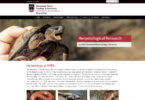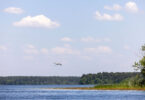Athens, Ga. – On the afternoon of March 11, 2011, a magnitude-9.0 earthquake spawned a massive tsunami off the coast of Japan that slammed into the island nation’s eastern seaboard, devastating homes and buildings for miles and killing nearly 18,000 people. As the water receded and rescue efforts began, international attention quickly turned to the Fukushima Daiichi nuclear power plant, where three reactors suffered meltdowns, releasing dangerous radioactive material into the environment.
Although much more stable today, nuclear disaster sites like Fukushima can remain contaminated for years as radioactive materials continue to disperse and threaten the safety of surrounding ecosystems. Environmental contamination is not a problem limited to nuclear disasters. Humans introduce a host of contaminants to the environment every day in the form of pollution, industrial waste, chemical spills or agricultural runoff. People depend on science to determine danger and outline steps needed to mitigate threats to humans, wildlife and plants.
Many of the world’s leading experts in the field will meet June 16-20 at the University of Georgia for the 12th International Conference on the Biogeochemistry of Trace Elements. Here, scientists from more than 50 countries will meet to share cutting-edge research about the management of sites contaminated by mining practices and other agricultural and industrial activities.
“The study of the availability, distribution, fate and transport of trace elements in our environment has become a critical component of many scientific disciplines related to environmental safety,” said Gene Rhodes, director of UGA’s Savannah River Ecology Laboratory. “Thanks to the research of the scientists who attend and contribute to this meeting, we will have a greater understanding of the roles and risks of common trace elements in our everyday environment and how these elements interact with the living world.”
In poster presentations and special symposia, experts from around the world will discuss the latest technologies and techniques used to evaluate waste management, water pollution, food safety, environmental toxicity, food chain stability and many other important indicators of environmental health. Event organizers are also planning a special session on the lessons learned from the Fukushima and Chernobyl nuclear disasters and how to better assess the environmental impacts of similar accidents.
“This is a very good venue for anyone to hear about the state of our environment with respect to contamination,” said Domy Adriano, who founded the conference in 1990 and is now a UGA professor emeritus.
While the theme of this year’s conference focuses on the management of contaminated sites, many of the experts also study how naturally occurring micronutrients behave in the soil and waterways, and the implications for farmers who want to get the most out of their land.
Information on the fate and transport of soil nutrients is especially helpful to participants from the developing world who are looking to build stronger, more reliable agriculture sectors in their countries, said John Seaman, a crops and soil science researcher at the Savannah River Ecology Laboratory and conference chairman.
The conference will explore the scientific methods and technologies used to measure contaminants in the soil and water. Scientists will also emphasize the importance of environmental stewardship and preservation of the natural world.
“We still face hard choices in regard to how we use our resources, which includes land that has been impacted by various industrial activities,” said Seaman. “This conference is very good at bringing together experts from all over the world to address some of our most pressing environmental problems.”
For more information about the conference, including links to symposia abstracts, see http://icobte2013.org.
Savannah River Ecology Laboratory
The Savannah River Ecology Laboratory, founded in 1951, is located on the Savannah River Site, a Department of Energy facility near Aiken, S.C. Scientists pursue a wide variety of ecological research projects designed to provide sound science for decision-making and environmental stewardship. The lab also provides opportunities for graduate and undergraduate research training, and service to the community through environmental outreach. For more information on the lab, see srel.edu.







